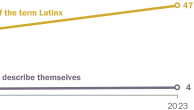As it continues to grow, the composition of the Hispanic population is undergoing a fundamental change: Births in the United States are outpacing immigration as the key source of growth. Over the next twenty years this will produce an important shift in the makeup of the Hispanic population with second-generation Latinos–the U.S.-born children of immigrants– emerging as the largest component of that population. Given the very substantial differences in earnings, education, fluency in English, and attitudes between foreign-born and native-born Latinos, this shift has profound implications for many realms of public policy, and indeed for anyone seeking to understand the nature of demographic change in the United States.
Since the 1970s, immigration has represented by far the fastest and the largest source of Hispanic population growth, and, as a result, the first generation–the foreign born–has become more numerous than the second or the third-plus generations–those born in the United States of U.S.-born parents. This demographic equation is now rapidly changing. Consequently, the effects of Hispanic population growth on the nation are shifting in important ways. Most simply, the largest impact over the past 30 years has been measured in the number of Spanish-speaking immigrants joining the labor force. However, in the current decade and for the foreseeable future there will be very sizeable impacts from the number of native-born Latinos entering the nation’s schools and in the flow of English-speaking, U.S.-educated Hispanics entering the labor market. Between 2000 and 2020, the number of second-generation Latinos in U.S. schools will double and the number in the U.S. labor force will triple. Nearly one-fourth of labor force growth over the next 20 years will be from children of Latino immigrants.
This study is based on new projections of Hispanic population growth from 2000 to 2050 developed by Jeffrey S. Passel, a veteran demographer and principal research associate at the Population Studies Center of the Urban Institute. Passel uses his own well-established methodology to disaggregate growth rates and other demographic indicators by generation (Edmonston and Passel, 1994). The result is a more detailed look at demographic trends than is possible from the Census Bureau’s projections or its published tabulations of data from decennial counts.




